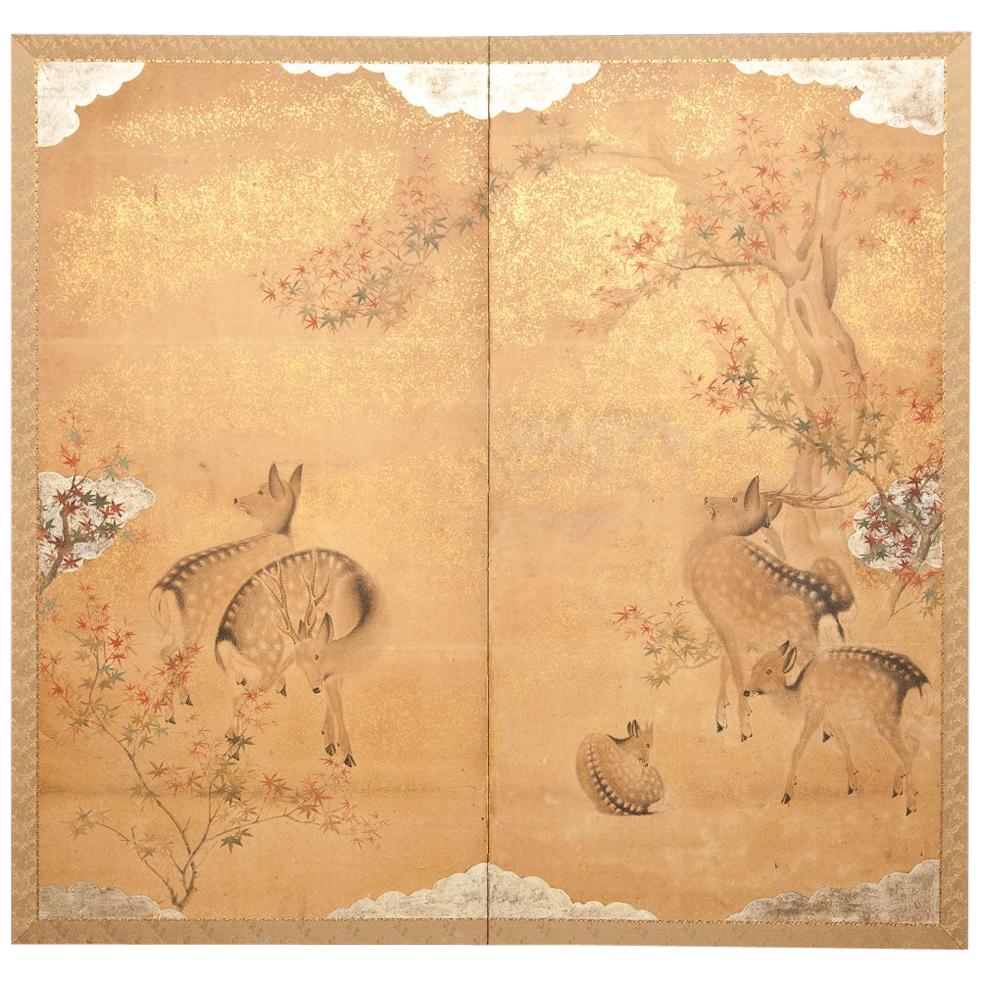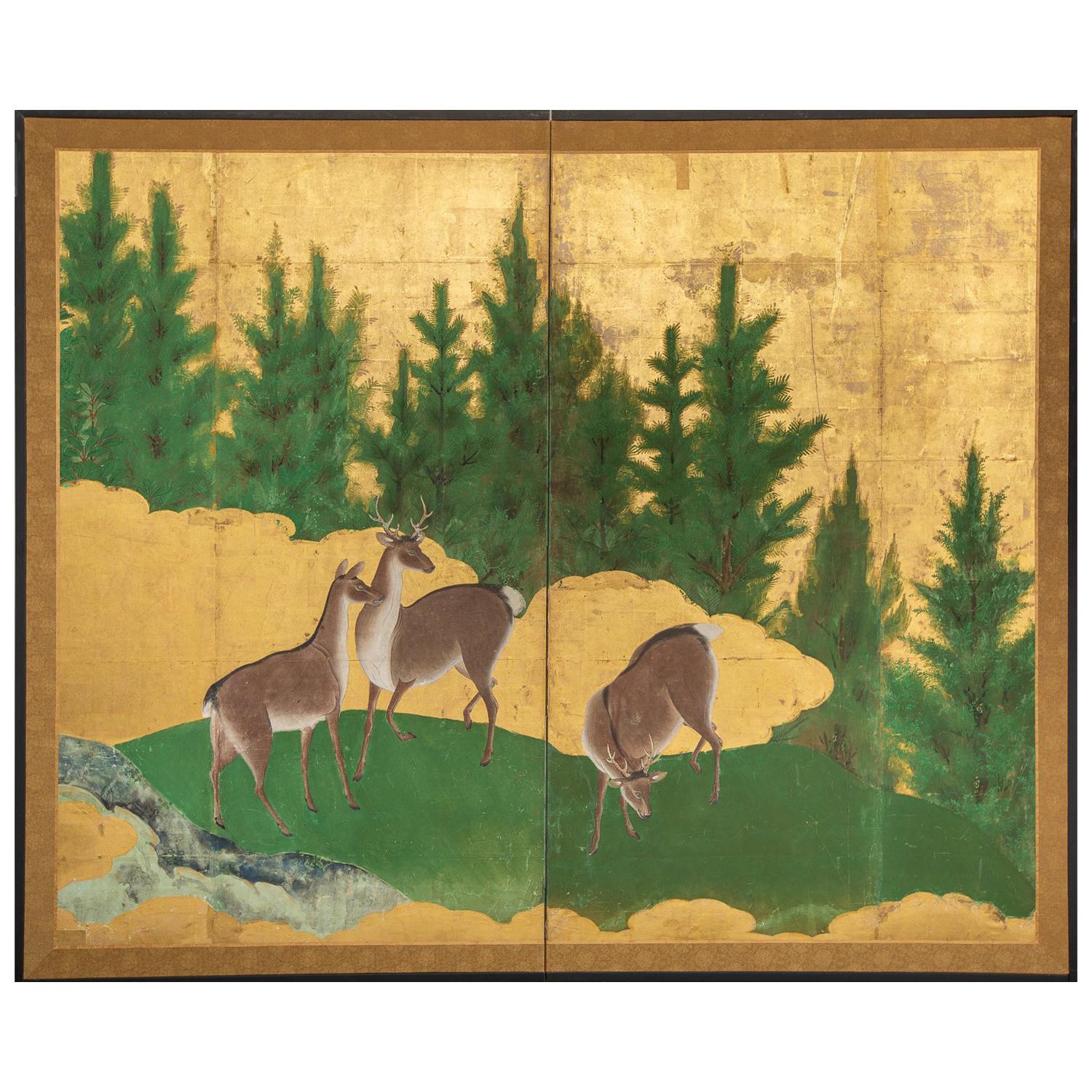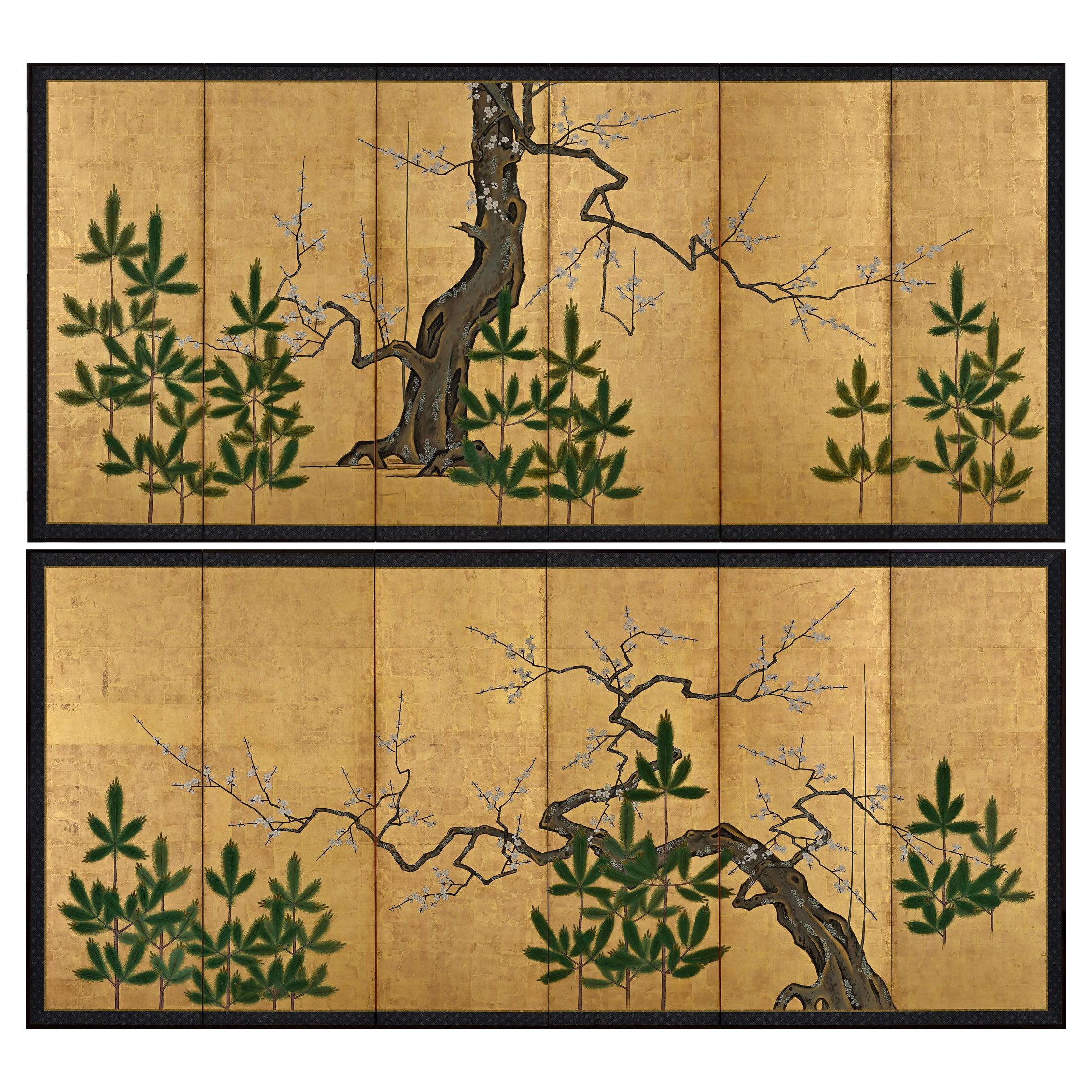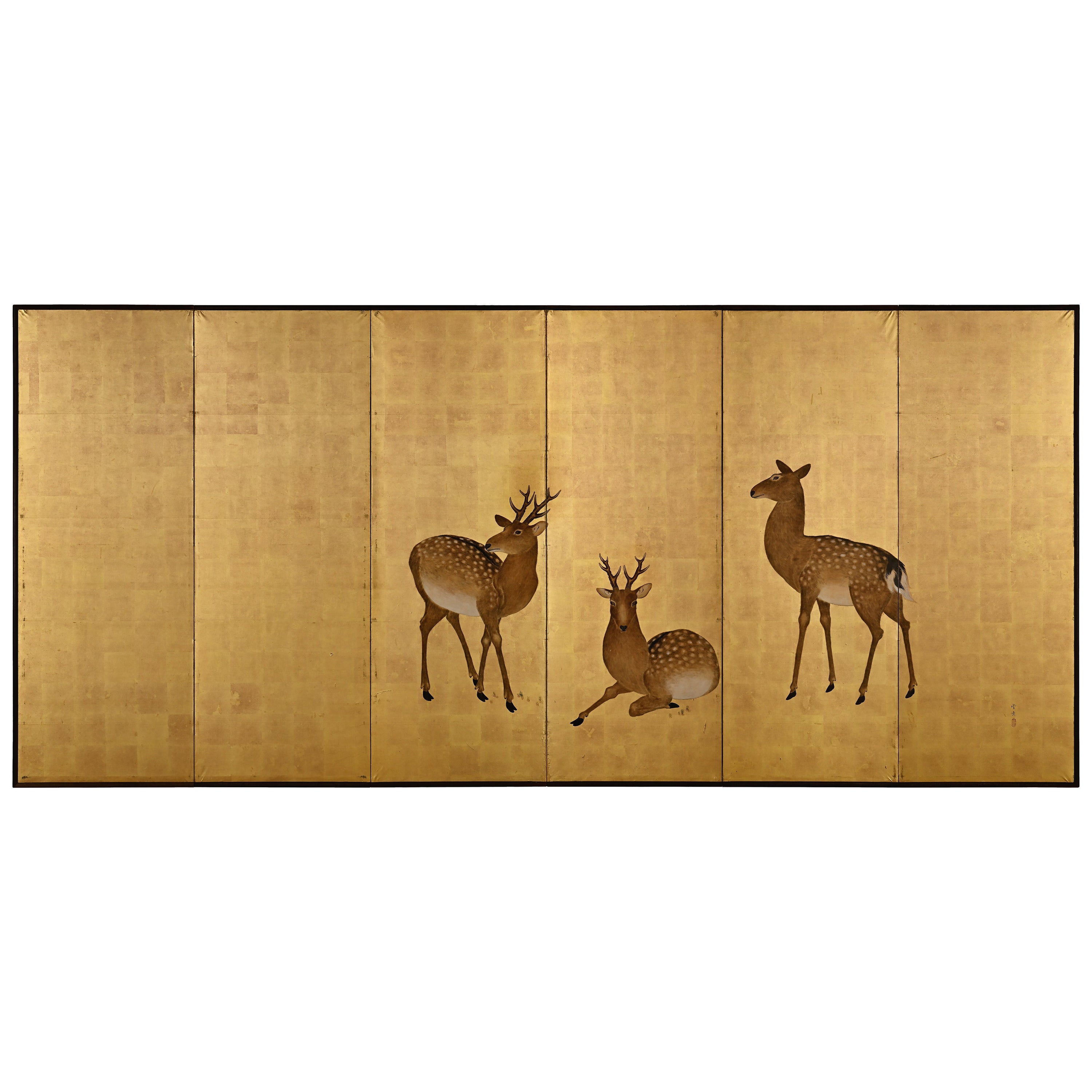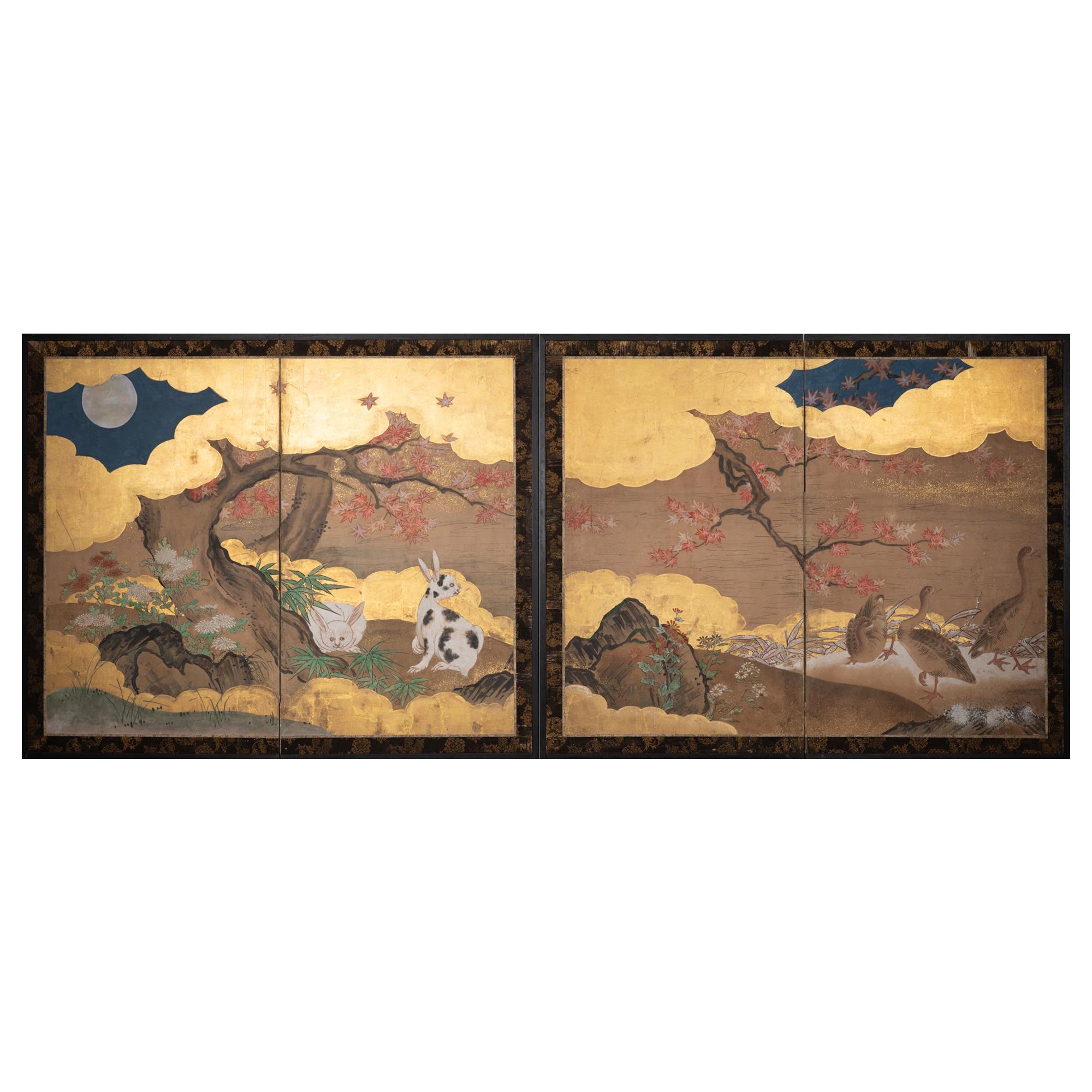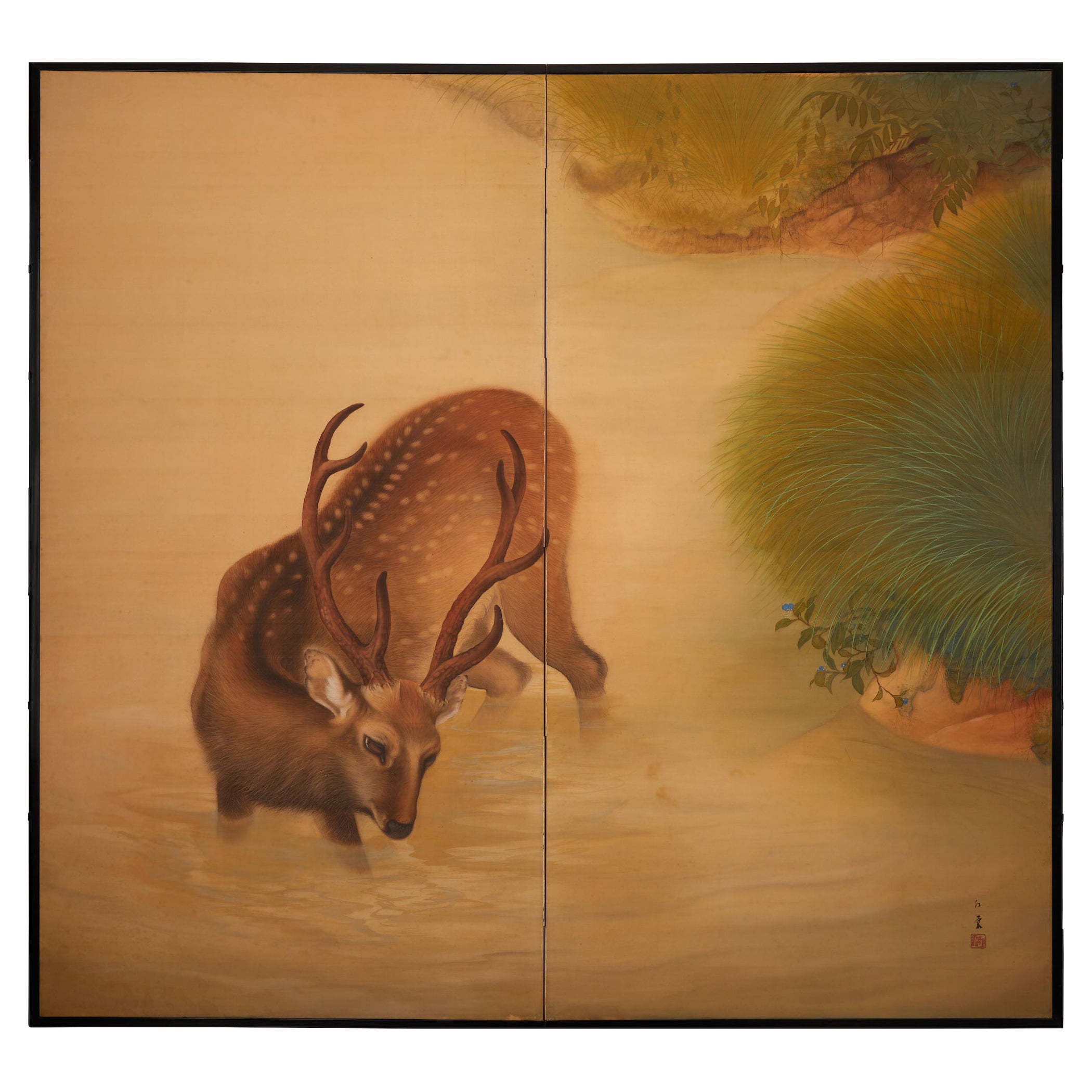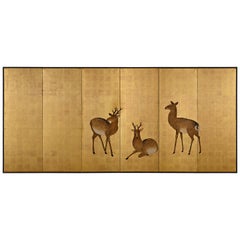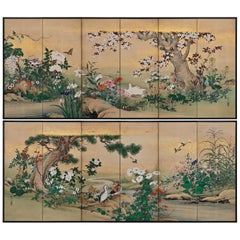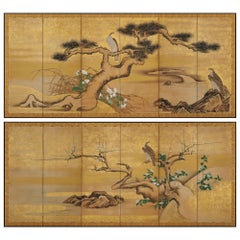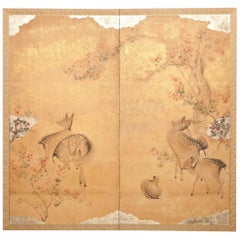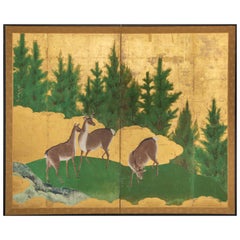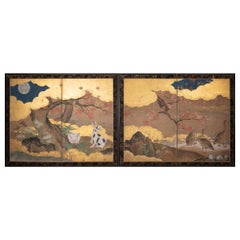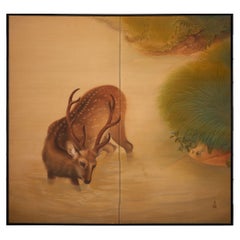Items Similar to Early 20th Century Pair of Japanese Folding Screens, Deer Under Maple Trees
Want more images or videos?
Request additional images or videos from the seller
1 of 9
Early 20th Century Pair of Japanese Folding Screens, Deer Under Maple Trees
$24,500per set
£18,564.07per set
€21,263.64per set
CA$34,701.49per set
A$37,867.37per set
CHF 19,862.08per set
MX$459,911.86per set
NOK 248,088.23per set
SEK 234,455.78per set
DKK 158,703.79per set
About the Item
Deer under maples
Late Taisho period, circa 1925-1930
Pair of two-panel screens. Ink and pigment on silk.
Signature: Goho
Seal: Goho
A pair of two-fold Japanese silk screens from the later Taisho period depicting deer under maple trees. In this shimmering evocation of spring, the doe is pictured with her fawn, their bodies entwined. The new leaves of the maple trees are painted with mineral pigments in lush hues of green. The delicate and meticulous brushwork of the deer contrasts dramatically with the heavily outlined foliage and the broad application of saturated colors. At the top right of the scene a faded vermillion railing peeks through the leaves. This visual clue likely alludes to the parklands of Nara where deer freely wander. Shinto religion and local beliefs hold that a deity named Takemikazuchi arrived in the old capital of Nara on a deer to act as the city's protector, and as a result, the deer of Nara are considered sacred, messengers of the gods.
In this pair of screens the artist is not overly concerned with creating the illusion of three-dimensional space, but rather seems to be interested in stylizing the shapes and forms of the depicted subjects. The work brings to mind the vividness and excess of the Rinpa school, and represents the liberalism of the Taisho period as it is being drawn toward the more geometrically organized, rigid compositions of the Showa period.
Both the signature and seal read Goho. There is a possibility that it is the work of an artist named Tanaka Goho from Wakayama prefecture who died in 1929. Unfortunately we do not have information to make a judgement.
The screens display perfectly and have been conserved and fully re-mounted in Kyoto utilizing traditional techniques and craftsmen.
- Dimensions:Height: 67 in (170.18 cm)Width: 74 in (187.96 cm)Depth: 0.75 in (1.91 cm)
- Sold As:Set of 2
- Style:Taisho (Of the Period)
- Materials and Techniques:
- Place of Origin:
- Period:
- Date of Manufacture:circa 1925-1930
- Condition:Refinished. The screens display perfectly and have been conserved and fully re-mounted in Kyoto utilizing traditional techniques and craftsmen.
- Seller Location:Kyoto, JP
- Reference Number:1stDibs: LU2472320999382
About the Seller
5.0
Recognized Seller
These prestigious sellers are industry leaders and represent the highest echelon for item quality and design.
Established in 2001
1stDibs seller since 2016
72 sales on 1stDibs
Typical response time: 1 to 2 days
- ShippingRetrieving quote...Shipping from: Kyoto, Japan
- Return Policy
Authenticity Guarantee
In the unlikely event there’s an issue with an item’s authenticity, contact us within 1 year for a full refund. DetailsMoney-Back Guarantee
If your item is not as described, is damaged in transit, or does not arrive, contact us within 7 days for a full refund. Details24-Hour Cancellation
You have a 24-hour grace period in which to reconsider your purchase, with no questions asked.Vetted Professional Sellers
Our world-class sellers must adhere to strict standards for service and quality, maintaining the integrity of our listings.Price-Match Guarantee
If you find that a seller listed the same item for a lower price elsewhere, we’ll match it.Trusted Global Delivery
Our best-in-class carrier network provides specialized shipping options worldwide, including custom delivery.More From This Seller
View All18th Century Japanese Screen Pair. Plum & Young Pines. Kano School.
Located in Kyoto, JP
Dimensions (Each screen): H. 176 cm x W. 378 cm (69’’ x 149’’)
This pair of Japanese folding screens depict blossoming plum trees amongst young pines. They are designed to capture t...
Category
Antique Late 18th Century Japanese Edo Paintings and Screens
Materials
Gold Leaf
19th Century Japanese Screen, Deer in Spring, Maruyama Shijo School
Located in Kyoto, JP
A six-panel Japanese folding screen from the leading Maruyama-Shijo artist Okamoto Toyohiko (1773-1845). Simply featuring three deer and a few sprigs of foliage on a sumptuous gold-leaf background this work emphasizes naturalistic expression and a masterful use of negative space. Reduced to its most basic elements, the blank spaces inspire imagination and evoke the smells, sounds and even the weather of the scene. Whilst deer are traditionally depicted in association with autumn, here the green growth on the tops of the foliage indicates the season of spring. The work references Maruyama Okyo’s two-panel deer screen...
Category
Antique Early 19th Century Japanese Edo Paintings and Screens
Materials
Gold Leaf
19th Century Japanese Screen Pair. Flowers & Birds of the Four Seasons
Located in Kyoto, JP
Flowers & Birds of the Four Seasons
Pair of six-fold Japanese Screens. Ink, color, gofun and gold on paper.
Second half of the 19th Centur...
Category
Antique Late 19th Century Japanese Meiji Paintings and Screens
Materials
Wood, Paper
17th Century Japanese Screen Pair by Soga Nichokuan, Hawks on Pine & Plum Trees
Located in Kyoto, JP
Hawks on plum and pine
Soga Nichokuan (active circa 1625-1660)
Pair of six-fold screens.
Ink, mineral pigments, gofun, gold and speckled gold l...
Category
Antique 1640s Japanese Edo Paintings and Screens
Materials
Wood, Paper
Mid-18th Century Japanese Screen Pair, One Hundred Flowers, Chrysanthemums
Located in Kyoto, JP
Omori Soun (b. 1704)
Chrysanthemums - One Hundred Flowers
A Pair of Six-fold Japanese Screens. Ink, color, gofun and gold leaf on paper.
Dating ...
Category
Antique Mid-18th Century Japanese Edo Paintings and Screens
Materials
Gold Leaf
Meiji Era, Circa 1900 Japanese Screen Pair, Flowers & Birds of Spring & Autumn
Located in Kyoto, JP
Flowers & Birds of Spring and Autumn
Unknown artist.
Japan. Meiji period, circa 1900.
A pair of six-fold screens. Ink, color, gofun and gold leaf on paper.
Signed: Gaga S...
Category
Antique 1890s Japanese Meiji Paintings and Screens
Materials
Gold Leaf
You May Also Like
Japanese Two Panel Screen Nara Deer in Gentle Yoshino Landscape
Located in Hudson, NY
Japanese two panel screen: Nara Deer in Gentle Yoshino Landscape. Yoshino is in the Nara Prefecture, an area famous for these small and tame deer native to J...
Category
Antique Early 1900s Japanese Meiji Paintings and Screens
Materials
Gold Leaf, Silver Leaf
Japanese Two-Panel Screen, Deer in Cedar Landscape
Located in Hudson, NY
Originally fusuma doors, three deer stand in a clearing in a pine forest with gold leaf mist. Mid Edo period painting in mineral pigments on gold leaf wi...
Category
Antique 18th Century Japanese Edo Paintings and Screens
Materials
Gold
Pair of Japanese Two Panel Screens Rabbits and Geese in Autumn
Located in Hudson, NY
Screen A: Autumn Scene with Geese in a Gentle Landscape. Lovely painting depicting geese under maple, in a gentle water landscape. Mineral pigments on paper with gold leaf clouds.
...
Category
Antique Late 19th Century Japanese Paintings and Screens
Materials
Paint
Japanese Two-Panel Screen, Wading Deer
Located in Hudson, NY
In Japan, it is a Shinto belief that the deer is a treasured and sacred animal. This admirable scene captures this gentle creature in its natural habitat with beautiful detail in bot...
Category
Early 20th Century Japanese Paintings and Screens
Materials
Silk, Lacquer
Japanese Two Panel Screen: Trees in Floral Landscape
Located in Hudson, NY
Japanese Two Panel Screen: Trees in Floral Landscape, Edo period painting (mid 19th century) of pine and other trees amongst flowers, with bamboo shoots on the right panel, and white...
Category
Antique Mid-19th Century Japanese Paintings and Screens
Materials
Gold Leaf
Japanese Two Panel Screen: Garden Scene
Located in Hudson, NY
Bamboo, chrysanthemums and garden stone in mineral pigments on a gold silk ground. Black lacquer trim with well patinaed bronze hardware. Signature and seals read: Seido Senshi
Category
Early 20th Century Japanese Paintings and Screens
Materials
Bronze
More Ways To Browse
20th Century Japanese Screens
Antique Japanese Silk Screen
20th Century Japanese Silk
Japanese Silk Painting 20th Century
20th Century Folding Screen
20th Japan Painting On Silk
Hand Painted Silk Screen
Japanese Folding Screens
Japanese Folding Screen Screen
20th Century Japanese Folding Screen
Japanese Folding Screen Art
Pair Deer
Japanese Taisho Screen
Antique Asian Folding Screen
Asian Art Painting Pair Wood Panel
Japanese Maple
Japanese Painting Tree
Pair Of Japanese Screens
